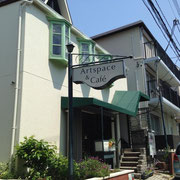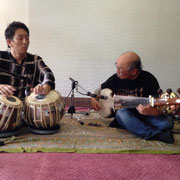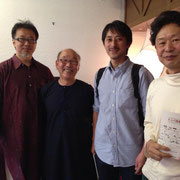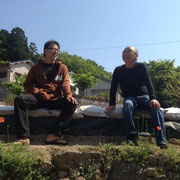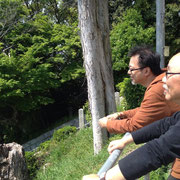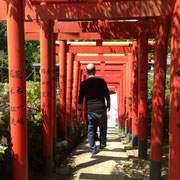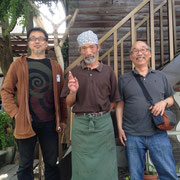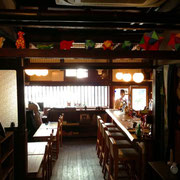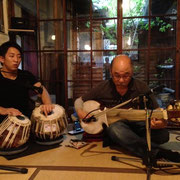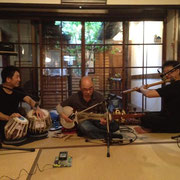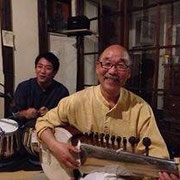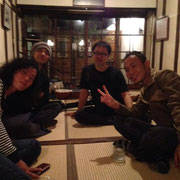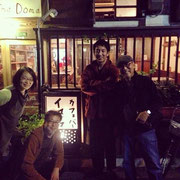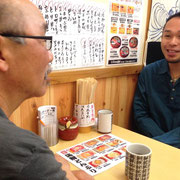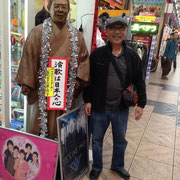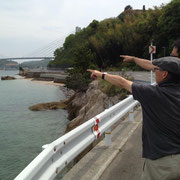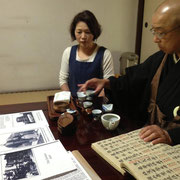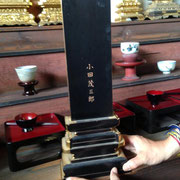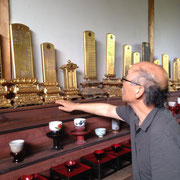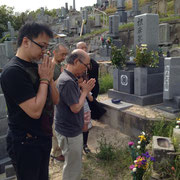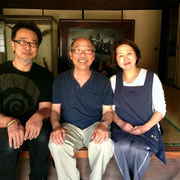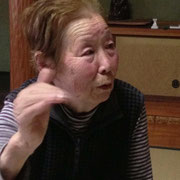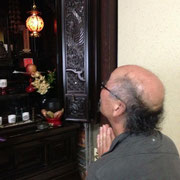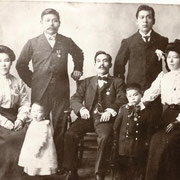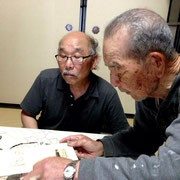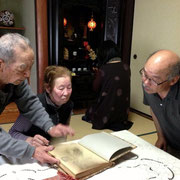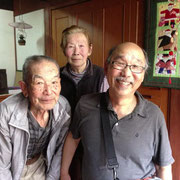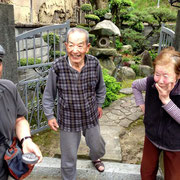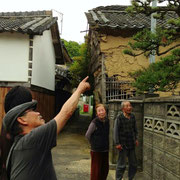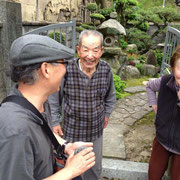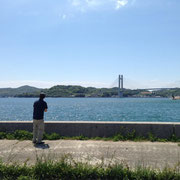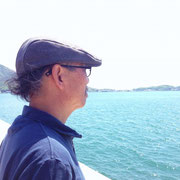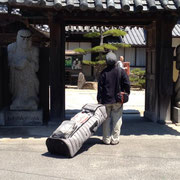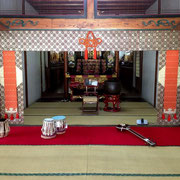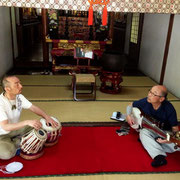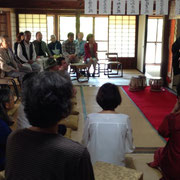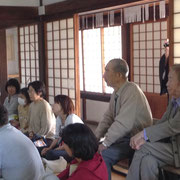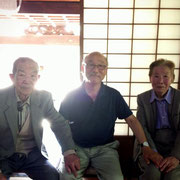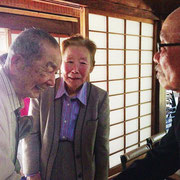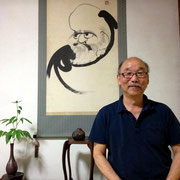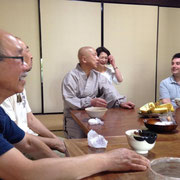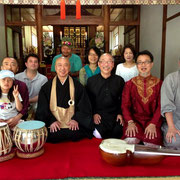This is a translation done by Ikumi Takahashi of a story written by two wonderful people named Yuriko and Taro Terahara that was originally published in Japanese on their blog which I am reproducing here with their consent and encouragement.

Visiting His Grandfather’s Hometown
I wonder what the young man was imagining crossing this blue expanse of sea. It was the Meiji era when he decided to live in Canada as an immigrant.
This is the record of our small journey to seek for the roots of Steve Oda. He is a classical Indian musician and the third-generation Japanese-Canadian.
Prologue – Encounter
It was 2007 when we first met Steve Oda. He was visiting Japan with an American tabla player, Ty Burhoe, for some events at yoga studios around Japan.
If you are Japanese, you will immediately get a sense of his connection to Japan. Just like “Steve” sounds familiar for westerners, “Oda” is one of the very well know family names in Japan.
My name is Yuriko. I produce concerts for Indian classical music, and I love writing. I live in Chiba, a prefecture of Japan located in the Greater Tokyo Area with my dear husband Taro, who is an Indian flute (bansuri) player.
One day, I was talking with Rie Kimura about a concert she annually produces in Nigata. Nigata is located in the Central region of Japan, facing the Sea of Japan. Taro and U-zhaan, a Japanese tabla player were the two main musicians for that event, and they were also there to give us some ideas. That was when I heard his name, Steve Oda, for the first time. U-zhaan sugeested us to invite him to the event. “Sounds like he would be in Japan around that time.” U-zhaan said. A Japanese Canadian whose name I had never heard, nor his playing. But U-zhaan was confident and Taro knew both his name and music from an album released by Vinit Vias, a tabla player in Canada. Soon after that, I received his profile from U-zhaan and thought that he must be a very difficult and strict person from his portrait.
Ty and Steve were invited to Japan by Studio Yoggy, and they were staying at a very fancy hotel in Shinjuku. The real Steve who we met at the lobby of the hotel was a totally different person from my imagination. He was a very humble, cozy guy with peaceful, gentle eyes, and calm atmosphere. This is the real Japanese-Canadian Mr. Oda who plays sarode… it was at the after party of our concert in Nigata when the truth of who he really was, sunk into my awareness.
His Music
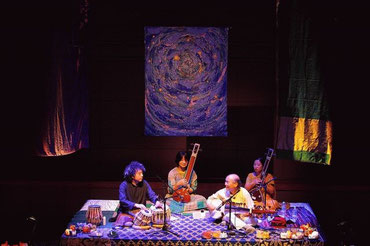
Below is from Taro’s blog on Mixi, an online Japanese social networking service, about Steve’s first tour in Japan which made a vivid impression upon us. It is a long story but let’s just quote what he says. Courtesy of Taro Terahara:
“Cycles”, an Indian classical Concert at Koidego Cultural Hall on the14th of November 2007 was legendary. Steve Oda’s sound was outstanding as such. Most all the audience had heard Indian music for the first time on that day, and they shed tears for his raga (melody). The venue was covered with many candles. In the swaying of the candle lights, I watched Steve’s performance which took all of us, the whole venue, on a journey somewhere outside of our living life. I had mixed feelings of mortification, envy, despair and euphoria. “When will I be able to create that kind of music?” “Will I someday be able to face Ragas like that?” It was the most beautiful Kaushi Kanara I had ever experienced. I was devastated and couldn’t stop crying forever.
When Steve is not on the stage, he is a small, gentle man, just a general sort of man in the normal world. He looks totally Japanese but indeed a Canadian-Japanese who can hardly speak Japanese. He is a sincere person who has no vanity and is so earnest about music. And that quality appears in his sound.
It was 1890 when his grandparents left Japan. The 22rd year in Meiji era. Steve’s parents were both born and raised in Canada, married and raised Steve and his brother. They passed away without ever visiting Japan. So he had a particularly profound feeling about this visit, which was the first visit to Japan in his lifetime. And furthermore, it was a return to his family roots after 120 years, counting from his grandfather’s departure from Japan.
The venue had a warm and welcoming atmosphere. Even though the organizers and staff had no experience running a concert, I could tell how much effort they had put into creating this wonderful event. There were colorful cloths that were laid on the stage, Indian saris decorated the background and the blue spiral painting “beyond a desire”. The flame of swaying candles, fragrance of Kouboku (a fragrant wood), a title “Cycle” that was raised at the reception desk. Delicious curry and Chai. Goods for sale and a questionnaire collection box are also on the table. And the acoustics of the hall sounded so natural and beautiful. We had all aspects present for a good concert.
We were told from people familiar with the matter that it will be a big success if 100 people come. As it turned out, we had near the twice as much in spite of it being a weekday night. I was vaguely planning to play Maru Bihag in the morning when we headed to Niigata. Why don’t I leave Vilambit Tintal to Steve, and go for rupak. However, after hearing his sound check, I changed my mind. A fantastic atmosphere of the venue and the scent of Kouboku. I decided to go for the most relaxing raga for myself, which is Puriya Kalyan. Yet, the Maru Bihag that I was planning in the morning, was stuck in my head. Like a lingering scent, was unexpectedly strong. So this mixture turned out as Maru Bihag-ish Puriya Kalyan.
Steve, who appeared in the second half, played the masterpiece as described above. It was impressively awesome. I actually felt like listening to Ali Akbar Khan in the 80’s. I had never imagined that there was anyone in the world who can play like this. At the end, I joined him on stage again and played Pahadi Dhun together. We were behind the scheduled ending time, so we rushed to pull out after the concert and headed to the hotel for an after party, and to enjoy the hot springs.
At the Hot Springs
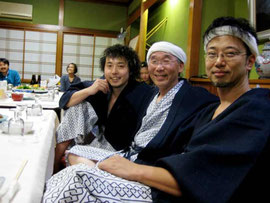
Rie Kimura who sponsored the wonderful concert at Koidego Cultural Hall had booked Ohyu Onsen Japanese Inn for our after party. This Inn, Yoshidaya is actually run by one of Rie’s parents. Rie was also one of the members who helped the concert. We had a very fun party with thoughtful and beautiful hand made dinner, with local Nigata Sake.
Here is a photo of happy smiley Steve in his first Yukata, a casual kimono wrap, sitting in between U-zhaan and Taro. He looks like a friendly Japanese gentleman.
Extract taken from Taro’s diary:
The lunch venue was just a short drive from the concert hall. At the foot of the Ginzan (Mt. Silver), there is Kappo ryokan, Yoshidaya (a Inn for Japanese cuisine) in Ohyu Onsen area. That was also our accommodation that night. Steve had his first Japanese hot spring experience, on his first trip to Japan, at a real traditional hot spring Inn. I think this could really be the very best hospitality for Steve, more so than any luxurious hotel, or posh full-course meal. Yuzawa (U-zhaan) explained each dish to Steve that was served to us one by one. “This is, eh, sort of … a kind of vegetable. Then, this one is also a kind of vegetable.” Steve seemed happy to listen to his style of explanation. When Yuzawa pointed the next dish “Oh, Inari!*” Said Steve.
*Inari-zushi is a fried bean curd stuffed with vinegared rice. The fried bean curd is simmered with a salty sweet sauce before stuffing.
He knew Inari. “My mother made it Canada. “ He continued. I was speechless. His parents were forced to live in camps during the war, and when they were released, all their belongings were taken. From there, they raised Steve and his younger brother with an unimaginable amount of effort. His mother was born and raised in Canada, and past away before ever coming back to Japan. The mother made him Inari-sushi. “I’m really happy to be able to play in Japan,” Steve says. His eyes are so calm and warm. “I think my father and mother are delighted, too” he continued. His parents had hoped to visit Japan someday but it didn’t happen after all. I thought they are visiting Japan with Steve now.
It would have changed a great deal since the Meiji era, when his grandparents left Japan, but there are still a lot of good old things still present from that ancient time. I felt grateful to be a part of this concert. I’d like to express my gratitude to Rie and everyone else who made this happen.
His Music 2
In Taro’s diary, he also talks about one of Steve’s concerts held at a yoga studio in Yokohama. He went there as a guest, just to listen to it. I’d like to introduce that part of his diary for your reference to get a sense of why we are so in love with Steve’s sound and what is so special about Steve’s, art of the Sarode.
Today’s venue is in Motomachi town in Yokohama city. They laid a carpeting on the floor of yoga studio to create a stage, which reminded me of one of my tours in Australia. Their choice of Raga was Charukeshi. Without hesitation, the hit of his very first note, komal dha with Andolan (a slight swing of a note) turned the whole space completely into the mood of the raga. phew…
How this person can slide straight into the core of the Raga so naturally, and perfectly. Why is the door so open for this man? Although I think I know the answer. That’s because he is living in Raga. All his life is dedicated to it. There is no act in his Alap.* His personal intention doesn’t exist. I mean, there is not a bit of boasting about what he can do, or his intention to impress the audience. He creates every single note precisely in the manner of the raga, in the way the raga’s nature truly is. He has the delicacy. He has the accuracy. You might not recognize the amazingly refined quality of his art form from your first experience, just because his style is not about flashys phrases or tihais. His devotion is apart from entertaining with fast playing or the giving of a unique impression with unusual notes. His 35 years of training must have all been focused on the delicate control of the sound and the understanding of the raga. And I am here, deeply appreciating the out come. I have to say that his accurate stroke is at the level of paranormal phenomenon. Every single note has the mood of the Raga. And there is no sound without necessity in the flow. From my eyes, who is understanding far below the level of his feet, Steve Oda’s sense of stability is beyond human ability. Each and every notes are at the level of Divine beauty “Kya bhat hai”. All the cells in my body raise their voices “ This is what I had been longing for. This is it. This is the true Indian music.”
* the beginning part of performance without accompaniment.
Where is Your Hometown? Looking for Clues
Steve currently lives in the town of San Rafael, near San Francisco in California, with his wife, Pushpa. It’s been a few years since his visit became an annual event. Meanwhile, the idea of taking him to the land where his grandfather was originally from has been a big theme in our mind for a while.
In the early days when we met him, he even wasn’t sure the name of his hometown. His answer was like “Shiga? Shikoku? “. But now, we know that it is in “Ehime” prefecture of “Shikoku” region. Even so, Ehime prefecture is pretty large. I’m from Okayama which is relatively close to Ehime, though, I have only been there for its famous Dogo Onsen (hot springs). It almost felt like catching a cloud when we thought about how we can get closer to his grandpa’s hometown.
It was last Spring that we took a big step closer to his hometown. On the way back from his Ecuador tour, Taro decided to stop by San Rafael to see Steve. I was back in Kurashiki in the meantime to take care of my mother.
One night, I got an email from Taro saying “I got more information about his grandfather. His name is Mosaburo Oda. He is from Sashima island in Ehime prefecture.” I rushed to my computer and found a map of the tiny Island. It was something, yet still only a very little amount of information. I finally reached one useful piece of information, which was that there is a list of immigrants at a National Diet Library in Tokyo, and we should be able to find information about people who have immigrated abroad from Japan. As I continued searching, I found his grandfather’s name from the list of immigrants on the website of that library. However, it likely required an actual visit to get more details about him. That’s all I could do for the time being, as I am in Kurashiki, about 682km away from Tokyo.
Researching
The search for his grandfather didn’t go any farther at that time, instead, I decided to examine the place, Sashima island. But there is very limited information available. As I kept looking at the map, zooming in and out, I realized that the town office, of which Shashima belongs, is on the neighboring island. I also found their website, so I called them. “Hi, a good friend of mine is looking for his grandfather’s hometown. We know that he immigrated to Canada from Sashima. I wonder if there are any clues or ideas to specify where it is?” I knew it would sound like catching a cloud, but anyway I talked to the person in charge of official family registry. “If the person in question can come to the public office and prove the relationship between that person and the grandfather, then we can show him the transcript of a removal from the family register”, said the woman who answered the telephone politely, yet in a matter-of-fact manner. Of course, it should be that way these days. At least now I know that there is such a thing as ”transcript of a removal from the family register.” I only knew about a family register. Because he immigrated from Japan to abroad, his register should also be removed… The word “removal” creates a bit of sad feeling. Anyway it might give us a clue to his birthplace.
So, how in the first place, can we prove the relation of Steve to his grandfather? He lives in the U.S. It is a lot of work, even for myself who is a Japanese living in Japan, to prove the relation to my grandmother with the official documents. I would need to go to the government offices all over, to arrange the family registry copy. Is this where we meet the dead end? If I can’t get the info for his birthplace, then purhaps I can find out about his grave site? So I thought, and asked “How many temples are there on the island?” I narrowed it down to this point. If we visit these temples, we might find his tomb. I thought. “There is only one temple in Sashima. You might be able to get some information from their family register of death”, which is called “KAKO-CHO” in Japanese. This information is encouraging. So, if luck is with us, this one temple might be the family temple of Steve’s grandfather’s family. Yes, it must be. I thought. “May I have the name of the temple?”, pushing it forward. “It’s called Saihoji”, “SAI HO JI?” “Correct. The chinese character for SAI is the West, HO is direction, JI is for temple.” The word Saiho must be from “Saiho Goku Raku Jo-do”, the sacred place of Buddhism, the pure land where Amida budha is, in far far East. I suddenly felt my sight get a lot clearer.
All right, we will take Steve-ji to the temple. Then he will finally realize his long time desire to go back to his ancestor’s hometown! Nevertheless, I’d never heard of the word “KAKOCHO”, despite the fact that my grandma’s parents run a temple. A family register of death… It must be something that has many records about the past. What is Sashima like? Can we get there by train or bus? Probably there is only a ferry, then what would be the best option for our transportation after getting there? Is there a bus running through the island? If not, then a taxi? Is it easy to find the temple? I continued searching some websites where we might learn more about the island. Pretty soon, I found someone’s blog who had traveled around Sashima with an image search. It says, “A small island with no diner or accommodation. We can cross the bridge from the neighboring island to get there.” It had some pictures of Sashima, which show beautiful green nature, the ocean and sunny sky. One of the rural landscapes of Japan. Probably, the person randomly took these photos when they walked around. Nothing in the photos could provide more information however. Although, it would be wonderful if Steve could get a feel of the island where his grandfather was born. So, I sent the link to Taro, wondering if Steve would enjoy the photos taken by someone we don’t know. That was really all the support I could give his from Japan at that moment.
Something Japanese
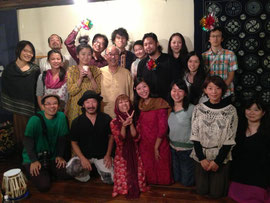
In fact, Steve’s performance tour in the fall was originally scheduled to play in Hiroshima prefecture with Ty which is relatively close to Sashima Island. We were excited about taking him to the island, but unfortunately the concert was cancelled just before they came to Japan. It was disappointing, but tour schedules often have the risk of changes. It is sometimes the way of a musical life.
We greeted Steve in the Kanto area as usual and had some concerts. We try to pick traditional Japanese style houses and temples for venues when possible, in order for Steve to feel a closer connection to the Japan, that his grandfather had lived in. We always try to walk the areas where we can still see traditional Japanese buildings, and introduce him as much Japan cuisine when we are together. And hot springs, needless to say.
Those young Japanese performers who also support Steve’s tour, such as Fumie, Tomomi and Emma were also happy to introduce him to a variety of Japanese cultures like Kabuki and tea ceremony on their days off. Back when Steve wasn’t sure where his ancestor’s hometown was, we still always wanted to show him and give him as much experience of the scenery of the era when his grandfather lived. I think that is what we all thought about when we were with him in Japan.
A Record of Mosaburo Oda
Meanwhile, Steve hosted Taro in San Francisco which was his first trip to the U.S. He took Taro to Ali Akbar College which is a School of Indian Music established by Ali Akbar Khan, and to the grave of Khan Saab, and even some Indian classical concerts, too. Thanks to the college, numerous numbers of top Indian musicians like Zakir Hussain and Swapan Chaudhuri are living in San Rafael where Steve lives. Sounds like it is Mecca for Indian musicians.
At the house, Steve showed Taro some documents that had been carefully preserved. The immigrants and their families had carefully left the records of their parents’ roots and made them into books. However, during the age when immigrants lived there, is more than one hundred years ago, and there were no computers to keep those records and even photographs were still so rare. All the detailed information there must have gathered by their own hands and recorded by their own memories.
The book has black and white photos of both his grandfather and grandmother, and their graves. It has all the infomation where he was born, what his Japanese family emblem is, how they got married, and how they lived in Canada. It is a whole history of Mosaburo Oda and his wife who immigrated to Canada from Japan and created their own family and lived together in a foreign land. The copy that was wrapped carefully is indeed Steve’s treasure. Taro took photos of some of these records and brought them back to Japan. Shall we go there? “Shall we visit the island where Steve’s grandfather was born?”
I decided to return to my hometown, Kurashiki city, where my mother lives, at the end of this year after a while, and I was looking at flight schedules. An idea came to my mind and I asked Taro. “Steve’s grandfather’s Island is in Ehime prefecture, isn’t it? Do you think we can go to Kurashiki by car from Chiba?”
I don’t have a driver’s license, which means Taro will be the only driver. It would take an hour and half to get from Chiba to Okayama by plane, but 8 to 10 hours by car, and we will need to have some break which will definitely add some more hours. I didn’t expect him to say yes. Though seems like he’s got some skills after touring Australia with Shen. He just said “ Good idea. Sounds good to me.” My proposal passed unexpectedly easily. If we have a car there, then going to Ehime doesn’t take that long. It will be very convenient for our life in Kurashiki, and we will be able to go anywhere, anytime we like. We also thought about renting a car, but having a time limit doesn’t go well with good research. Before taking Steve there, we wanted to know how we get there and what is the island like. But there is so little information out there, let’s just go there by ourselves. So, Taro, would you please drive from Chiba to Okayama all by yourself? Without much of any fixed plan, Taro was happy to do this adventure.
Preparation Trip
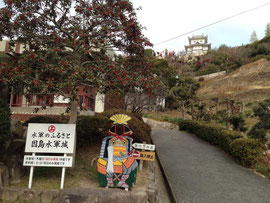
After we arrived at Kurashiki, we had no time to unwind at my mom’s house and headed off to Onomichi city the next day. I checked the location of the island on the internet. It’s a small island. Looks like there is a ferry route, but I wasn’t sure whether we can go by a car or needed to leave the car at another island. Sounds like there is a bridge called “Shimanami Kaido”, a nearby island. After that, we will know when we get there. Anyway let’s see how far we can go. We are ready for anything. I felt like we were going on a great adventure.
It’s about an hour and half drive on a toll road from Kurashiki to Onomichi. The toll road is called Shimanami Kaido, which continues to Imabari in Shikoku area connecting several islands. We got off at the south exit to Innoshima. The scenery, full of densely packed islands in Setouchi inland sea was quite spectacular and beautiful. It looked like Shimanami Kaido is a popular path for cyclists. Bike paths are in place, and rental bikes are available at so many spots. Taro’s eyes were shining, seeing those bikers, because he is also a tour bike lover. I was wondering if he would say “Lets get out of the car and go by bike!” I am not a biker, but was excited to imagine how exhilarating it would be to ride a bike in such a landscape.
Interesting signboards showed up, one after the other, after getting off Innoshima exit. “Oh, there is the Murakami navy castle! Wow, Innoshima was once a pirate island! Oh, that’s a guy from the famous movie, Hikaru no Go!” It’s an entertaining island. We were looking for some useful information, and found a building with a rusty signboard saying “The birthplace of PORNOGRAFFITTI (a famouse Japanese pop band).”Is that so? It might be the reason why I knew the name of this island. We decided to go to a Museum of the Murakami navy, just because it sounded interesting. I asked the lady who was at the window if she knows the way to get to Sashima. She pointed at the map of Innoshima which is at the entrance and said “I think there’s a ferry port on the south side of the island, and there’s a ship out there in operation.” She also told us that it is a really tiny port.
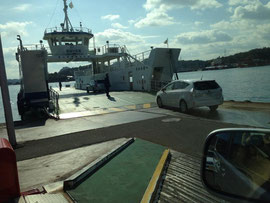
Nothing was really sure yet but we aimed at the ferry port which is the only clue we had. Going for Sashima Island. “There is a ferry to a neighboring island and then across a bridge to Sashima.” Relying on my memory of some information I ran across from a random website, we were looking for a ferry pier to Ikinajima Island. We went back and forth and finally found the terminal. Looks like we can get on the ferry with our car. We lined up behind some other cars. I got off the car and bought a round-trip ticket at an old kiosk. The ferry came into the port after I was back in the car. One after another, these cars boarded. People, bikes and motorcycles filled the open space between to the cars.
I had imagined a two story ferry that we would get out of the car and move to a room on the 2nd floor to enjoy our boat trip. But it was a totally unexpected type of a ferry. It was like a whale shark or a sting ray, flat, more like a hand cart looking ferry loaded with several cars, pedestrians and motorbikes. It moved very flat to the opposite port. No one even got out of their cars until we got to the Ikinajima Island. Everything was a new experience. Whole system was so simple, there was no time to be impressed by it, and we drove down the slope to get off the ferry.
Then I saw a sign saying “Sashima →” just in front of us!… Sashima! We followed the arrow. Ikinajima Island is not as big as Innoshima, but is not as small as Sashima. Our expectation was growing more by the minute. We drove tracing the edge of the island and reached the bridge which crosses to Sashima. That’s Sashima! We are finally here!!
Found the Saihoji Temple!
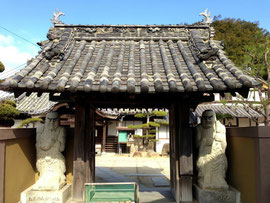
From Ikinajima Island to Sashima Island, there is a new bridge that was cleaner than I thought. The road was also newly paved. It wasn’t the rusty old bridge that I was expecting.
Anyway we finally had arrived at Sashima island. We parked our car in an open space by the sea. We could see one signboard saying “ Shashima Port.” Ok, we should check the temple first. But now my map app doesn’t show any signs of a temple and there is no one around. We got out of the car and soon found a map on a board. But again, no signs of a temple. Hummmm, what to do now? When I stopped looking at the map and just looked around, then I realized that there is a traditional looking building just nearby. As we got closer, we saw two statues with thick eye brows on both sides of the gate. Above the gate, we saw the words ” Saihoji temple” There it is! This is the only temple on the island!! It was indeed a small temple. If there were no signs, I would think it was a normal private house. I stepped onto the stone pavement and tried to call from the entrance.
“Hello? … Is anybody here? Hello? …” After a while, a lady came out from the back, wearing a suspicious mask. I totally get it. It must not be a common event for them to have a random stranger visiting them. Moreover, we have the look of a doubtful, middle-aged man and woman who are dressed very casually. I understand her hesitation.
Various thoughts ran through my mind, wondering what questions or suspicions they would have on this very small, closed island. People may say things like “don’t ever talk to outsiders!” or “it must be the curse of the God of island.” Showing our best non-suspicious look, I apologised for our sudden visit, and explained what brought us here. As soon as the woman got a sense of what is going on, her mood immediately softened and led us to a room beside the main hall. “ Please come in.” she said.
A Death Register
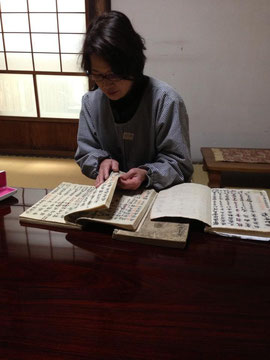
As we sat in the room, the lady came back with some books bound in traditional Japanese style. These books are all titled “ The death register.” “Chief priest is taking the day off today,” she says, and goes over the books. This is what the death register is like, I thought looking at the book from her side. All the pages are full of words with a skilful brush stroke. A variety of information is added in vermilion colour beside thick characters written in black. Looks like, all kinds of information such as the date of someone’s death, posthumous buddhist names, the cause of death and names of their relatives have been recorded here. As she turns the pages, she confirmed the information that we were looking for and stopped her hand, “is this the one you are looking for?” That was it. Mosaburo Oda. This has to be him. There we also found his posthumous buddhist name. This temple had all the information we were searching for.
“I think we have his mortuary tablet.” She said and led us to a room in the back of the main hall. There was an array of mortuary tablets. “We actually have several Oda names here…” she said and grabbed one with some posthumous buddhist names on the front side in her hand. When she flipped it over, we saw the name clearly that we were looking for, “Mosaburo Oda”. “There he is!” Our excitement reached a climax. We found him here! It is Steve’s grandpa!
We checked the family crest on the mortuary tablet against a photograph that Taro had taken in the United States. Definitely the same crest. Tears came up. “Would you like to visit his grave?” said Atsuko. “We’d love to!” we replied without hesitation. It was at a slightly elevated part of the hill behind the temple. While she showed us to the correct spot, Atsuko was on the phone confirming exactly where the spot was with their chief priest. All the ancestors of the people on this island must be enshrined here. We found three old graves, built in the densest area which perfectly matched one of the photos from Steve’s materials.
An Old Storehouse with Thick Earthen Walls
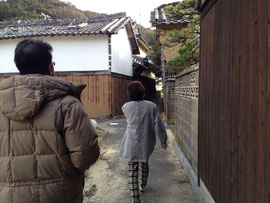
“These days his relatives are taking care of the tomb, and I think his remote relatives live in Mozaburo’s house.” “What? Mosaburo’s house? Is it still here?” Atsuko pointed in the direction and said “ yeah, that way.” But of course we have no idea what we should expect there. “It’s walking distance from here though.” She continued. “Well, if you don’t mind, would you please have a drive with us and lead us to his house?” Amazing, we actually found a lady who knows his house. We must go there, right? I know it could be impudent but I asked her anyway. “Oh, of course, I can do that.” She responded willingly with a friendly smile.
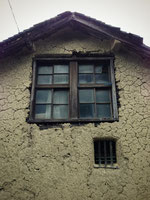
“This is the place.” The house we arrived at thanks to Atsuko seemed to be empty. An old house with a large garden. It was so touching to be at the exact place where Steve’s grandfather had lived. We did not expect that we would ever get this far on our first, trial trip. As we turned to the back of the house, we saw an old decayed storehouse with thick earthen walls. We could see through the frames, and could just make out the shape of a house. It seemed to crumble upon our first steps in the house. I could see old farm equipment, and some jars from the falling gaps in the mud walls.
While we were taking some photos of the storehouse to send a report to Steve, Atsuko’s suddenly disappeared. She was talking with someone at the entrance of the house, next to the storehouse where the “Oda” nameplate was. She told us that this is Mosaburo’s relative’s house. As we approached, the elder lady with gentle eyes, who was listening to Astuko invited us to come in.
Mrs. Shigeko
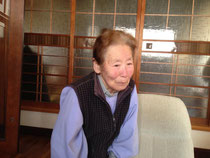
Her name is Shigeko Oda. “I often heard about Mosaburo from my grandfather.” She said. Mosaburo is a cousin of Iwataro who is Shigeko’s grandfather. Their grandfathers are cousins, which means Shigeko and Steve are the second cousins. “My grandfather always said that Mosaburo was a great person.” She told us that Mosaburo invited her grandpa, and Iwataro went to Canada for salmon fishing. Shigeko is over 80 years old. She seemed to recall various things gradually while repeating the same story again and again, just as if she were tracing the thread of her distant memories. “We were often scolded by him for being extravagant.”
In Canada, the grandfathers needed to wrap their hands with old cloths because they didn’t have gloves when they went out salmon fishing in the cold rivers. “People called us Jap, hey Jap! there. It was the hardest job I’ve ever had.” Her grandpa told her the story so many times. She also told us about her name which has one same Chinese character of Mosaburo’s. It is because Iwataro respected Mosaburo so much, he took one letter from Mosaburo for his grand daughter. Shigeko lost her parents very early and was raised by Iwataro.
“Grampa also said “if people on this island worked as hard as the people from this island who worked in Canada, this place would have been abundant.” She mumbled. “Oh, I think Mosaburo got his wife from Mitsunosho.” That must be about Steve’s grandmother! Her birthplace wasn’t listed in the material Steve possessed. It was new information. “Mitsusho is in Innoshima Island. I am from that island, so I’m familiar with that name.” Atsuko told us the additional info. She stayed and listened to Shigeko with us.
A Photograph
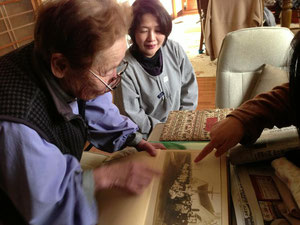
Mosaburo was planning to come back to Japan. He was preparing for it, but just before it happened, he died in Canada. “There must be some pictures of Mosaburo’s funeral in this house.” She went to a back room. After a while, she came back holding an old album. A photograph of the funeral was on the last page of the album. Shigeko’s grampa respected and loved Mosaburo and kept the album so dearly.
In that photo, a lot of men with Japanese faces in full dress were surrounding a coffin and a Canadian looking priest standing in front of a small church, looking in this direction. The line of the Japanese attendance which continues endlessly to the depths of the photograph tells us that Mosaburo was a virtuous figure in the community. “Steve has the exact the same photo which he showed me that at his home in San Rafael. I didn’t expect to see it again here!” Taro was surprised and showed us the photograph on his cell phone. They were exactly the same.
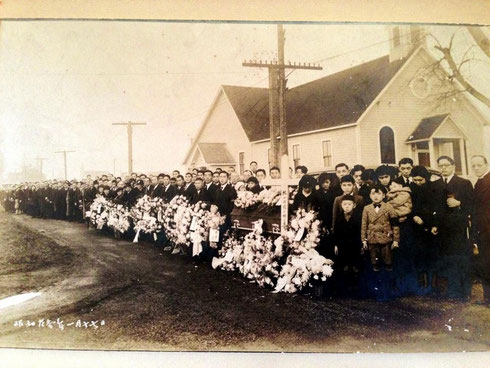
The Island with a Population of 300 People
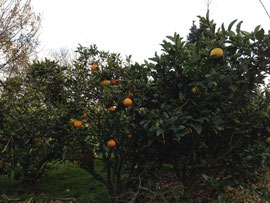
We left her house saying “thank you” to each other again and again, and promised to bring Steve back in the near future. Shigeko also had gentle eyes, just like Steve. We need to come back here as soon as possible, while she’s doing well. Both Taro and I have made up our minds.
After taking Atsuko back to the temple, we decided to go around the island by the coastal road. A small island with a population of about 300 is comprised mostly of fields and forest, except for one area around the temple where the population is concentrated. There are also citrus trees standing along the road next to each other, and we can see the ocean behind it. Each tree had an abundance of big orange fruits. In some places, harvesting was in progress, but wild trees were also growing throughout. A large amount of unharvested fruits fell and the ground was dyed orange.
The road dead ended after a while in the mountains. So we turned around in a narrow space, and drove back the same road we came. There were no people or cars passing by on this single lane road. Although a few ladies who we passing by gave us big welcoming smiles. They must know that we are from outside of the island. Maybe it is due to the warm weather of the Seto Inland Sea. I felt their warmth.
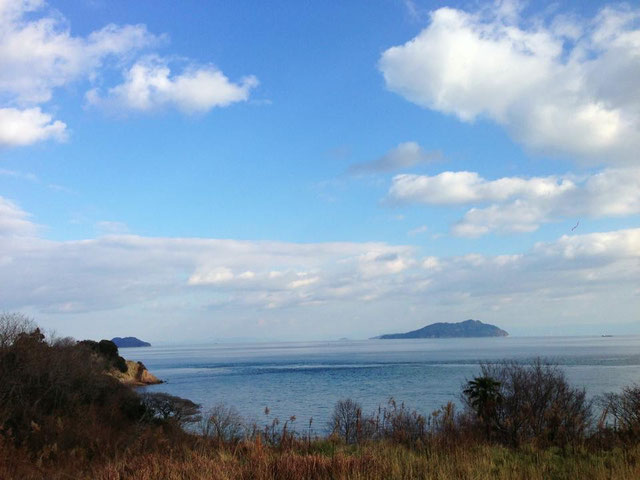
A Report
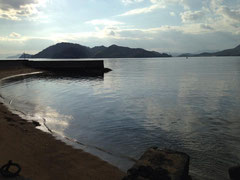
We returned to my mom’s house with the glowing result, far beyond what we had expected for this trip. We immediately sent the photos and information of what we discovered to Steve in the United States. “Unbelievable! Really?”An excited message came back from Steve. “Did you find my grandfather’s Island? Not only that, but also his house? Besides that, you met my relatives? Am I dreamimg? I can’t wait to go to Japan!! Thanks so much!!” After several e-mail exchanges, Steve finally said “ Taro, I’d like to fly out right now! This has been a big theme of my life, I want to go there soon. I don’t think I can wait until our next tour in September!”
After several times of emailing back and forth, he said, “Taro-san, I think I should just fly out there. Discovering where we are from and who I am, has been such a huge deal in my life and I cannot wait any longer to find it out. It would be very hard to wait until my next Japan tour happening in September.” He had visited Japan for so many years, yet the journey to search for his roots had not been realized. However, now it has finally become a reality. This is how Steve decided to come to Japan in April.
The Beginning of the Journey
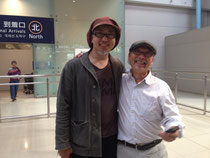
On April 23rd, Taro and I headed to Kansai Airport just after we finished a concert at Oto-ya-kintoki, a live music studio in Tokyo. Steve arrives at an Airport at 3:00 pm on the 24th and Taro will drive from Nishi-Ogikubo in Tokyo, to Kansai Airport by himself. So, we took a nap for about three hours at Makinohara Service Area in Shizuoka prefecture. Then we passed the famouse hairpin curve on the Hanwa expw. It was a straight shot, driving across the sea, to the airport. We saw one airplane landing to the airport drawing a beautiful trajectory from our right hand. When we arrived at the airport, we realized his plane had landed 10 min ago, which means he was on the plane that we just saw. Soon we got to the arrival gate, and shortly after, Steve-ji showed up with his sarode and suitcase. “Welcome back to Japan.” I hugged him, full of joy. Taro and Steve-ji hugged each other tight. This was the beginning of our humble, yet very special 10 day journey.
Remembering the Food
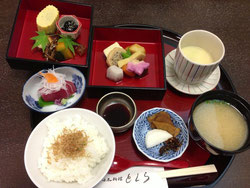
The next day after arriving at Kurashiki from the airport, I decided to take them to lunch at a nearby Japanese restaurant called “Tokura”. My mother loves yummy food and knows many restaurants in this area. And she picked this one for us. Moreover, it is walking distance from her house which is where we all were staying. They use the best broth ever, for cooking foods from the mountains and the sea. We had a great time enjoying delicate Japanese dishes. Steve-ji also admired each and every dish. His chopsticks joyfully carried food into his mouth. He picked a savory steamed egg custard, and asked me “Is this Chawanmushi? “Correct.” I answered. “My mom used to make this for new year.” “Really? In Canada? ” “Yeah. And this sweet black beans and candied dried sardines, too.” “I guess she made Osechi, which is a traditional New Year’s food.” “Well, .. Yes, I think that was Osechi!”
Steve’s childhood memories of the New year were coming back. He remembered his family home, “A lot of people came to greet us at our house, one after another, and my mother stayed in kitchen for cooking all day. We also went to various houses on New Year’s Day to give our greetings.” His mother, who had never come back to Japan, kept the Japanese food culture there. One of the Japanese customs followed in Canada. Language tradition has been interrupted by war, but memories of Japanese dishes are still connected. It is filling my heart from the first day of our journey. I think it is going to be a really nice journey.
A Gig in Kansai Region, in the Southwestern Half of Japan
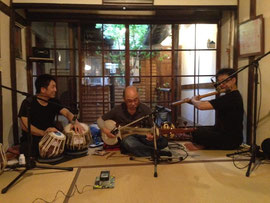
This tour had been planed in a hurry, so the theme was a dedication performance to Sashima island, except for some gigs in Ashiya, Osaka and Kurashiki, Okayama which was our home base. Of course, when we have Steve-ji in Japan, we’d of course love people to listen to his performances.
The first day that he arrived at Japan, we drove from Kansai Airport to Kurashiki, and at night, we went to a hot spring called Seto Ohashi Onsen, ther Great Seto Bridge Hot Sprig, and stretched our bodies. The next day we had a relaxing day at my mom’s home to recharge our energy for coming concerts.
Taro’s old friends came to the concerts at Gallery Takasefune in Ashiya and Osaka Imadoma. Somehow I thought Kurashiki isn’t too far from the Kansai region, I set our base in Kurashiki and was planning to go to the venues from there. But indeed it was a very long drive, even though we used toll ways. In order not to empty all our energies just by driving, we asked our friends if we could stay over at their houses after both concerts. In spite of my sudden request, they accepted us pleasantly. I am so grateful for their support, from the bottom of my heart.
Here I’d like to say thank you very much to Miss. Oue and Mr.Tadao.
Photos from Kansai Region
That Song…
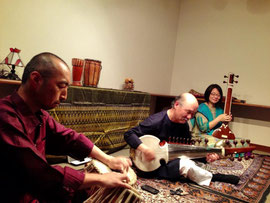
It happened in the last song of the concert at Penny Lane in Kurashiki. On this tour, Taro shared Steve’s journey to his hometown with the audience at each venue. Steve-ji was on sarode, Mr. Bessho was on tabla, I played tambura, and Taro joined us on bansuri for the last song.
Steve-ji’s performances were really amazing at both events. I mean he is always wonderful, but I felt something very special on this tour. When the venue was filled with the mood of Indian ragas, suddenly we heard a very familiar melody that probably all of us can sing along… what is it… the moment when I recognized the song, I became very emotional. Oh, Steve-ji! I saw Taro stopped his motion just a second. It is a very well known Japanese children’s songs, Furusato, which means “a hometown”.
We felt such deep emotion that he would put in that song when he played it. Just to think about the long history, with so many dramas that his ancestors, and himself, had gone through up until this present moment. And now he is playing this song in Japan… I felt a heart pain and much more.
The lyrics of the song go:
“I hunted rabbits on that mountain.
I fished for minnows in that stream.
I still dream about those days I spent when a child.
How I miss and long for my old country home.”
After the gig, Taro said “I had no idea that you would insert the song there,” to Steve-ji. “I’d practiced this song for a long time” Steve-ji replied with smile. And he played it. Yes. It was so Good. Thank you.
To Onomichi City in Hiroshima Prefecture
There are no guesthouses nor restaurants in Sashima island which has a population of only 300. However it will not be enough to be there only for a day for a dedicational performance, because he must want some time to feel the island where his grandfather was born, and we really want him to spend time with Mrs. Shigeko. Additionally, we want to look around Mitsunosho town which is his grandmother’s birthplace. With that in my mind, I booked a guest house in Onomichi for three nights.
From the previous trip that Taro and I made, we learned that going to Sashima island from Onomichi city is pretty easy. Sashima is indeed in Ehime Prefecture, but from a distance point of view, Sashima is in Onomichi-Innoshima cultural region. And Onomichi is a touristic city, so we can find accommodation easily.
After a performance in Kurashiki, we had a casual “after party” at a pizza house run by one of my mid-school peers. Then headed to Onomichi with the tabla player, Mr. Bessho and his only daughter. It’s about one hour drive on a mostly single lane road. I had booked a 10 tatami mat main room plus 2 tatami mat room (16.56㎡+ 3.11㎡) spacious traditional Japanese room which can holds 3-5 people. The guest house was quite clean. I saw a map near the Sunshine Coast in Australia on the wall at their café on the first floor. The young Japanese couple who owns the guesthouse had just come back from a working holiday in Australia. The husband told us that there were many people that once immigrated from different islands in this area, and showed us a DVD which tells a story about one elder lady who immigrated from Onomichi to Canada. It was filmed by a Japanese Canadian woman.
The Navy Castle
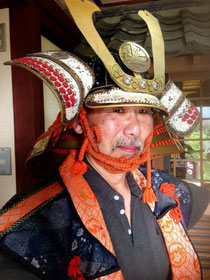
The morning of the day before the dedicational performance, we headed off to Mukaijima island. We took a ferry from the ferry port just by the guest house. Probably it is only about 500m trip to the island. It is a modern / mini version of a ferryboat, rather than a voyage, although it sells itself as the shortest voyage in Japan. Bikers and pedestrians also boarded, filling up the space between the cars. Once we arrived, people begin walking as if they had crossed a crosswalk.
Mukaijima island feels like an ordinary suburban city, rather than an island. The buildings, shops and houses look the very same as the ones on the opposite side, acrossed the water, which actually looks more like a river. It’s a very strange feeling. We drove to the bridge to the next island, Innoshima. As a view of the beautiful islands appears in front of us, Steve looks out the window and keeps his eyes gazing upon them.
Our appointment with Saihoji temple is in the afternoon. So we decided to visit Murakami Navy Castle first. There is a re-built naval castle standing on a hill overlooking the Seto Inland Sea. As we climbed up the stone stairs using bamboo canes, the view opened more and more. I thought about the sea pathways that once naval Chieftains stared at from here. A lady at the reception said “You can try on a navy helmet and a costume.” To Steve-ji and he tried them on. He looked just perfect.
To Mistunosho Island
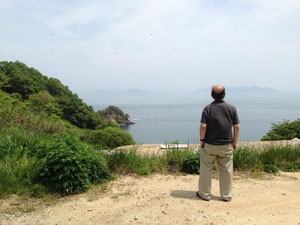
“I think he got married with a woman from Mitsunosho town.” Said Shigeko when we talked with her at the beginning of the year. Following that information, we decided to drive to the town. We parked the car on a hill and looked out at the islands, wondering if his gramma also once saw the same view from the same spot when she was a young girl. The name “Mitsunosho” means the 3rd village. It was more spacious than we thought. And we saw a lot of new houses instead of old rusty roads. Seems like the economy is doing very well here due to the shipbuilding business. As for his grandmother, we had only a little information, which is her name.
According to the documents that Steve-ji brought with him, they had an arranged marriage. Mosaburo immigrated to Canada when he was 19. He saw her photo there and decided to marry her. Meanwhile, his gramma must have immigrated to Canada with other people in a similar situation to marry the man who she knew nothing about.
In Canada, she made tofu, soy sauce and miso from scratch, and eventually ran a store. The Inarizushi that Steve remembered when he had it in Nigata prefecture was made with tofu and soy sauce that his gramma had taught his mother how to make. It is different from the tofu which we can easily get from any grocery store in Japan these days. His gramma made it from scratch in Canada where everything seemed so different from where she grew up.
An Interesting Encounter
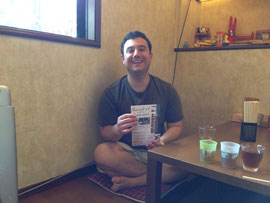
It was almost lunch time after visiting the Naval Castle and Mitsunosho town. To get to Sashima island, we need to use a ferry again to get to Innoshima Island which is right next to Sashima. We weren’t sure if we could find any restaurants there, and for sure, no place in Sashima. So, we decided to get fed before our next move. However, there weren’t many open shops in this considerably deserted shopping street. Fortunately we found an Okonomiyaki shop, Japanese pancake diner. We are in Onomichi cultural area which means the pancake will be made in the Hiroshima style. Perfect news for me, who is from Okayama prefecture and grew up with it. Soon, a puffy, delicious looking pancake was served in front of us. Steve seemed to be enjoying it, too.
It was then we heard some conversation in English and Japanese coming from the entrance. It was the family of a Caucasian and Japanese couple with their lovely children. They sat next to us. What a rare happening to see a foreigner in such a rustic place. “Where are you from?” I asked. “From Pennsylvania.” The husband who seems to be a nice person answered in fluent Japanese. “My wife is from this island, and we are staying here for about two weeks. We also lived here ten years ago.” he continued. “Well, he’s from the U.S., and we’re going to visit his grandfather’s home island.” I replied. “We are also having a dedication performance in Sashima tomorrow.” I showed him the flyer. “Oh my gosh!” his wife raised her voice. “Isn’t it your favourite instrument?” I thought “Oh, this is not the type of instrument that you think it is…” and kept explaining about the event. “It’s Indian music. Please come and enjoy if you like.” He stared at the flyer and said “My ipod is full of the music of one musician with this instrument.” “A musician of this instrument? You mean, Ali Akbar Khan?” “ Yes! That guy!!” “What?” we all were so surprised to almost flip over. “Really?” “Well actually, this guy here, Mr. Steve Oda is one of his disciples and is a great sarode player.” “What!? Oh gosh, you gave me chills.” His wife said in a raised voice. Indeed, they also gave us chills. What a coincidence. Serendipity! In a small Okonomiyaki diner in a rustic shopping area in one of many Setouchi islands. WOW.
“The place where we live in Pennsylvania is in the country side and I always listen to his music while watching the stars.” He also told us that he’s never experienced live Indian music ever. “I’ll be there tomorrow!” said Matthew excitedly.
Finally on Sashima island!
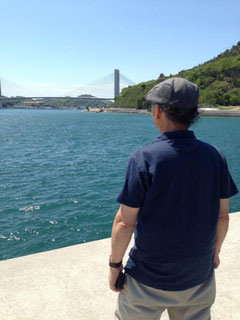
The exciting encounter with Matthew wrapped us with an uplifting mood in the car. What on Earth is this? I had a feeling that something was leading us somewhere. Is it you, Mosaburo?
The next ferry brought us to Ikinashima Island. From here to Sashima is so close like the closeness of ones eyes and nose. Alright, let’s take a deep breath now. Taro parked his car at the wharf where we can see Sashima island. It is finally happening. We could see how much it means for Steve-ji. The beautiful sea, islands, bridge and sky. He kept his eyes on the island quietly. Yes, he is finally here.
To the Saihoji Temple
After we got to Sashima island, we went straight to Saihoji temple. This time, the chief priest was there for us with Atsuko. They prepared several “family register of death” books for us. While the priest and Atsuko turned pages, Steve watched them, almost breathless. Mosaburo’s father’s, siblings’ and relatives’, their names were found one after another. The priest explained about each one of them.
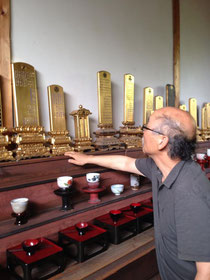
Mosaburo had made a mortuary tablet at Saihoji Temple to honour his family. The tablet that I and Taro looked at during our last trip in January, had Mosaburo’s name carved on the back, which means that it had been dedicated by Mosaburo. He planned to come back to Sashima and was preparing many things for his life on the island. But then, just before it happened, he died in Canada. His funeral was performed there with a huge crowd at a Christian church. His posthumous buddhist name was given by Saihoji temple only when his cremains were returned to Japan. That is the reason why the date of his death and the date of him receiving a posthumous buddhist name are different. His Buddhist name “深碧清水” consists of 4 Chinese characters. The first 2 characters mean ‘almost green, deep blue’ and the second half of the name means ‘pure water’. A beautiful name that reminds one of the sea.
New facts were also found. Mosaburo’s father’s name has conflicts between Steve’s material and the books from the temple. It is the same person according to his wife’s name and the date of his death, but the names were different. Apparently he had changed his name sometime in his life. The work for corroboration was indeed like solving a mystery. Later, we went to a back room behind the main hall to worship the mortuary tablet. The family crest, which Steve had only seen in some photos is clearly carved with his grandfather’s name. Steve reached for it silently and kept his hand on it. Usually, we Japanese don’t put our hands on the tablets to honour our ancestors. It was kind of funny, and at the same time, it was also sad to see that even though he looks completely Japanese, he doesn’t yet understand the culture.
The tombs of the Oda family were lined up on a hill of a mountain behind the temple. The priest read the letters written on the old graves. There is a picture of the grave in one of Steve’s documents which is exactly that tomb. We lit some incense sticks given by Tadao’s* mother, prepared flowers and poured water onto the grave. The priest chanted a sutra and we put our hands together gratefully.
* a good friend of all of us who came to one of our concerts with a sitar player, in Osaka.
Two of his Second Cousins
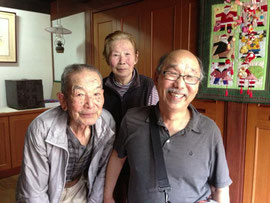
After the visit to the temple, we went to see Shigeko. This time, Shigeko’s husband was also at home. We didn’t know until then, but indeed, Shigeko and her husband Shigefumi are cousins, which means they are both grandchildren of Iwataro, who is a cousin of Mosaburo.
Steve and we were both really surprised to unexpectedly meet two relatives at once. Shigeko brought out many albums that once her grandpa cherished and now cherished by herself. Thanks to that, we were able to see one picture that we had never seen of Mosaburo’s splendid figure, surrounded by his relatives. “Well, what is this person to Mr. Mosaburo?” Shigeko asked me about Steve. “Oh, he is the grandchild of Mosaburo. A grandson of him, which means Mr. Steve here is your second cousin.” “OK, I got it.” She nodded and looked at the photos again. She gave us some more explanation of the people in the album. And then asked me, “Well, what is this person to Mr. Mosaburo?” She kept asking me the same question again and again. She was confronted with a person, right in front of her, who is very similar to herself, but can only speak English, and is actually one of her relatives! It seemed like this fact hadn’t been felt in a real way within her yet. But it looked like she does realise that he is somehow related to them. It might take time for her to let the fact sink into her mind properly. Both I and Taro repeatedly answered this question in the same way. She showed us a slightly confused, but happy face.
The Oda family is a lineage of historical warriors, and both Mosaburo and his father were very wealthy which was a surprise for me. Just to see the size of this island, and from the name of “Oda”, which in Chinese characters means ‘a small rice field’, I thought his family were farmers, and given a surname in the Meiji era. But the truth is that they have a long history in Sashima island and Mosaburo is from a ‘head’ family, while Shigeko is from a ‘branch’ family. We learned that Saihoji temple also has a long history and was in another place until it was reconstructed some hundreds of years ago. Sounds like this island has a lot of history.
Next to Shigeko’s house is the place where Mosaburo’s house once was. There is also a crumbling storehouse with earthen walls, barely standing on their property. “We hesitate to take it down.” Says Shigeko. It seems that the earthen wall has been broken down by wind and rain, we could see some agricultural tools and large bottles through the naked bamboo core structures. It looked impossible to get inside. If you try to open the door, it may collapse at once. It must have waited for Steve to come. In the days of Shigeko’s childhood, this storehouse would have been used daily. Who knows, Mosaburo might have been locked up in there by his father for discipline.
Mosaburo’s house had been dismantled, and those building material from his house were once stored in a government warehouse, but it had been reused and nothing is left. Now, they have some other building on the spot. There is a Jizo* in the corner.
*Jizo is a popular deity in the folk beliefs of the Japanese.
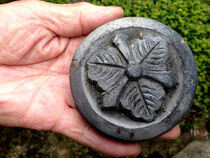
When I was telling Shigeko and Shigefumi that we were leaving, Taro, who was already outside found something and said, “look at that!” We all looked up in the direction where he was pointing and found a family crest on a roof tile of their house.” Oh, look at that! That’s the Oda family crest!” As we were delighted, Shigefumi went back to his house saying “There must be an extra one in the house. Please wait here a moment.” He came back with a small roof tile in his hand, it had the crest on it. “This is for you, please take it with you.” Steve was really surprised, and so grateful. By seeing all three of them smiling at each other, I had no doubt that they were indeed, real relatives. They saw us off to the outside of their house, as if they would miss us so much. They ended up walked slowly to the next corner and watched as we departed, even though they said they would come to the concert, which means we would probably see each other again the next day.
Drive Around the Island

After we left their house, we drove around the island. A series of citrus trees which were different from the ones we saw in the New Year, were lined up. We saw a small shrine at each corner of the road. Blue sea and sky through the gaps between the trees. It is a small island. We soon come to a dead end while looking at the citrus trees. Slowly, we make a U-turn and go back the same way. Steve was silent, just looking at the landscape of the island, as if he was burning it into his memory.
Another Story of…
We drove on the Shimanami Kaido, also called Nishiseto Expressway, back to the guest house in Onomichi. The owner, Mr. Takahashi handed over a DVD to us, saying “This is the movie I told you about.” We watch the DVD titled “Grandma’s Garden” on my computer. The story was about the “Grandma” of a director, Linda Ohama who immigrated to Canada from Onomichi. What was happening to her in the movie was so much like Steve’s grandfather and grandmother’s story which I am now seeing and hearing in reality. These story lines were overlapping each other so much, I became mixed up and confused. Ohama’s grandma immigrated to Canada when she was young, for an arranged marriage which begun with only a photo to introduce her to her soon to be husband. When Ohama’s grandma was interviewed in the movie, she was about 100 years old. She spoke mostly in Japanese with some English words mixed in, here and there. She had a distinctive stylish atmosphere that is typical among the people who lived abroad for many years.
Steve’s grandma went to Canada a little before the lady in the movie did. She was married to a samurai warrior family, she probably wasn’t as free as the lady in the movie, I thought. What I imagine is, with her strict husband, she followed the customs of Japan, cooked the traditional Japanese dishes they had in Japan, taught her daughters how to make Osechi, and arranged marriages for their kids with Japanese Canadians.
It is said that the immigration that had begun in the Meiji era, lasted nearly 100 years. Each generation must have had different kinds of fun in their youths as well as various family configurations. In the meantime, a big drama called “war” is brewing. A time when only Nikkei, Japanese descent were put into concentration camps, despite the fact that they were naturalised either in the United States or Canada. When they left the camp, all their houses, properties and everything else were taken up.
More information about Linda Ohama “OBACHAN’S GARDEN”. Japanese title is:
“おばあちゃんのガーデン” (2001):
http://blog.goo.ne.jp/sakura1043_2004/e/c1389b36f8e758ec3bd3f46958906e52
http://lindaohama.com/filmography/obaachansgarden.html
A Votive Performance
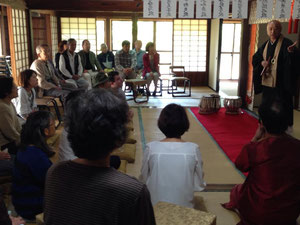
It was a clear sunny day in Sashima. Both, the sea and the green of the trees were sparkling. Nearly 30 people came to listen to Steve’s dedication performance. 30 out of a population of 300! Shigeko and Shigefumi were there, well dressed. They were delighted to see Steve again from yesterday, held their hands with a smile. Some friends of the tabla player, Bessho, came from the neighbouring island of Ikinajima. We also had Miss Minamino from Awajishima island, Miss Hiroko from Hiroshima city, and a master of a Japanese restaurant “Seika” in Kojima, who had told us “I’ll visit you there cause I love taking a long road trip on my motorcycle!”, came with his wife. Matthew, who we met at an Okonomiyaki dinner the day before, appeared by himself saying “My kids are too young to sit still, so I came here alone. I’m so excited for my first ever live music.” He sat in the middle of the first row. I was so excited to have him there, too.
Thanks to the priest and his wife who had spread word of the event, a lot of residence of the island came to the concert. The chief priest explained about the Oda family in the main hall where it was filled with a warm, welcoming atmosphere. “Oh, he belongs to the Oda’s” “I see, from the main family of the Oda lineage.” People were making such whispering voices. After that, it was Steve’s turn to share his story. At least, that was what we thought. However, he began to explain about his instrument as he usually does. In my mind I said, “Well Steve, maybe you can tell your side of the story….. then again, maybe it’s OK:)” I thought. Taro spoke up and supplemented some stories about his journey and how he was led to this place. “Oh, thank you, Taro,” said Steve.
Steve’s Performance
In the last song when Steve played the song ‘Hometown’, we saw a lot of smiling faces in audience. Tears were about to overflow from my eyes. With enthusiastic applause, our performance was over. We were full of gratitude, seeing people leaving the hall smiling, talking and sharing their experience of the foreign music, something they would have never heard before.
Thank you to everyone in Sashima for welcoming Steve Oda.
The hometown he had dreamed of, welcomed him with the best weather and the warmest smiles.
Photos from Sashima Island
At the End of the Journey
“I just can’t get one thing at all,” said Steve at the end of the trip. “Why my grandfather decided to leave such a beautiful island and immigrate to Canada.” I don’t have the real reason. However, one thing I do know is, the reason Steve, such a wonderful person / musician is here now, is because a young man, Mr. Mosaburo, followed his heart and journeyed out from Japan and crossed the ocean all those years ago.
Thank you, Mr. Mosaburo for putting a seed of this Steve here.
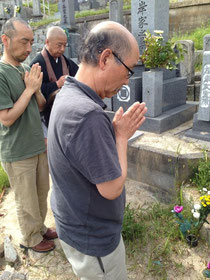
Next: Friendship Built on Indian Music Creates a Bridge to The Grandfather’s Island

